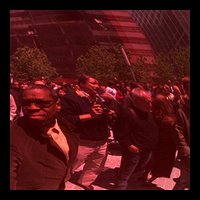"Everything Always Sounds Better in Latin"
 No matter one's age or background, when one hears Yale University's Sterling Professor Emeritus, Vincent Scully, lecture one cannot help but feel they are returning to an audience with their grandfather. Still with us to share in the follies of life, Scully is a man who walked among our legends. With first person accounts of Wright, Johnson, and Meis, his stories, however embellished, are the last authoritative human connection we have to those that struggled before. His passionate words echo from a deep corner of history, to remind us that our forefathers were ruled by the same petty fates, the same twists of coincidence, and same improbably dreams that guide our actions.
No matter one's age or background, when one hears Yale University's Sterling Professor Emeritus, Vincent Scully, lecture one cannot help but feel they are returning to an audience with their grandfather. Still with us to share in the follies of life, Scully is a man who walked among our legends. With first person accounts of Wright, Johnson, and Meis, his stories, however embellished, are the last authoritative human connection we have to those that struggled before. His passionate words echo from a deep corner of history, to remind us that our forefathers were ruled by the same petty fates, the same twists of coincidence, and same improbably dreams that guide our actions.With Scully, our inheritance, our history, becomes human.
It is with this sentiment in mind that DYWSC directs readers to this link, where one can listen to Mr. Scully in a recent eulogy to Philip Johnson. The speaker spends his time at a fundraising event, to defend Johnson from unsympathetic biographers and unfocused obituaries. The treat lies with the fact that Scully does his job with a vocabulary, wit, and analysis that can only be the fruit of a full and enriched life.
Below is a snippet of Scully contrasting the Meis van der Rohe Farnsworth House, and the Philip Johnson Glass house: buildings which at first glance might appear almost identical.
[16:59]...Now the inhabitant is open to nature on all four sides, but he's still alone. And he has to own enough of the natural world to insure his privacy. He has to be alone. No community group of buildings can be built on this model, unless one retreats to the closed courtyard.Alas, what a poor sound-bite to give about this podcast.
Of course Meis had already done almost the same thing - at least designed it earlier - with the Farnsworth House. But how different the two buildings are! As many have pointed out, Meis lifts his building up as an object, emphasizes the frame, and subordinates the glass. Johnson is just the opposite. He paints out the frame - paints it black - he sets the building down on the ground, and he emphasizes the glass with the datum of plate rail of iron in metal. The Meis [Glass House] can be read like a traditional building; like a little temple in the landscape, but Johnson's is only a volume, inhabited by a human being. Meis's for example, with it's detailing, recalls grand stairways, great loggias, great porches; Johnson's has none of these.
That's why Johnson's house is, I think, further along than Meis's, because one of the most
persistant and objective myths in modern art has been the liberation of the individual. The liberation of the individual from comunity, which is always depicted as disasterous for the individual in the mythology of Modern art; from family; from memory; from everything. There he [Johnson] is, alone, plugged into the glowing sources of power, therefore only with glass between him and Nature.
There is an important quality about this recording that has little to do with Architecture and much more to do with architects coming together to listen. The speech is about larger traditions in the struggle to be creative. DYWSC offers that this recording is so powerful because it’s one of the few examples where an architectural lecture need be received with the competitive analysis of a skeptical audience. We, as younger listeners, can rest from the inevitable post-lecture statements like, “It was good work, and an interesting proposition, but I would have…” That has no place here. In this eulogy, Scully is not about the construction of an architectural argument. The magic rests in the transportation, he was there, then. He can tell us what these men before us were like. It’s a dangerous position to listen uncritically, but Scully released us from that burden, temporarily. And offer us a comradery with men who share the same love for beauty in Architecture.

